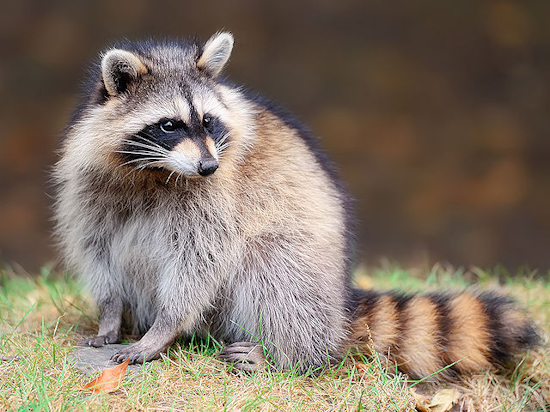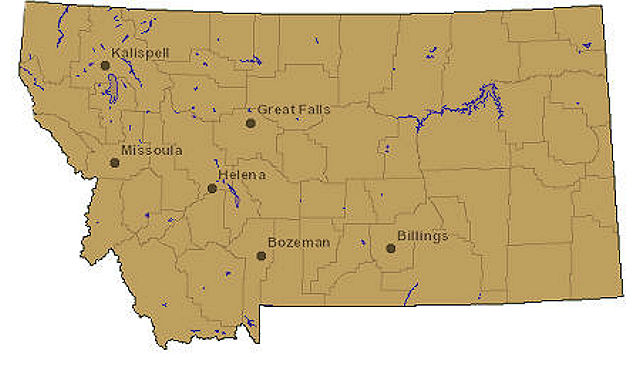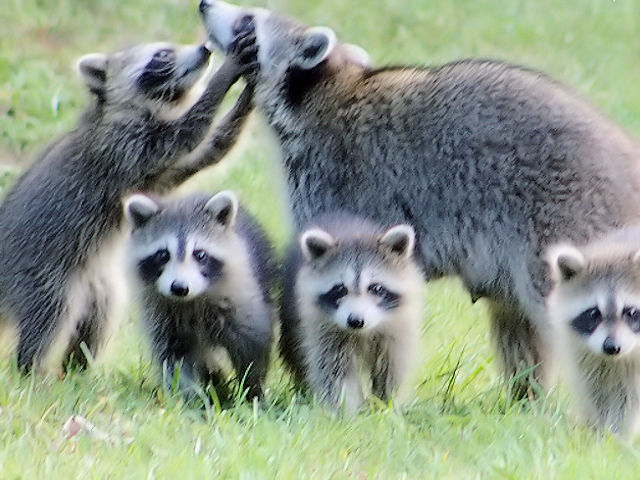Raccoon

Procyon lotor
Order:
Carnivora
Family:
Procyonidae
Other Names: Ringtail, coon.
Status: Moderate value as a fur animal. Abundant. Many people enjoy viewing them. Nongame animal.
Identifying Characteristics: Black mask over the eyes and alternating rings of yellowish-white and black on the tail. Flat-footed and body weight variable.
Total length: 26 to 40 inches. Weight: 12 to 35 pounds.
Habitat: Inhabits stream and lake borders near wooded areas or rocky cliffs. Most abundant in riparian and wetland habitats.
Food Habits: Omnivorous, will eat whatever is available. Feeds on carrion, mammals, birds, reptiles, insects, amphibians, grains, nuts, and fruits. Also readily consumes food prepared for animal or human consumption.
Life History: Mostly nocturnal and very intelligent. May use front paws to find food. Does not hibernate. Uses hollow logs, trees, and rock crevices as den sites. Breeds during February and March; 63 day gestation; young born during April or May; litter size is usually 2 to 4.
The Raccoon is one of the easily recognizable furbearers with a ringed tail and patches of dark fur over the eye areas resembling a mask. Known to many simply as a "coon", the raccoon is managed by some states both as a game animal and as a furbearer. This important and well distributed species is adaptable to a variety of habitat types and the species thrive in both wilderness and urban areas.
 Description
Description
Raccoon weights vary from region to region.
Generally, raccoons attain larger weights in
northern states and lighter weights in southern
states. Most adult male raccoons in northern
states weigh 15-18 pounds during fall harvest
seasons, with females averaging 2-3 pounds less.
In some southern harvest areas, mature males
weigh 9-10 pounds with females from the same
areas weighing 8-9 pounds. Occasional specimens
in northern states may weigh 30 pounds. Several
individual raccoons have been taken from the
wild weighing more than 50 pounds, but whether
these animals have been fed as captives is
unknown.
Raccoons have 40 teeth, including 4 elongated and sharp canine teeth. The hind legs of the raccoon are longer than the front legs, giving them a hunched appearance as they walk or run. Toes number five on each foot and the front feet are dexterous, allowing the raccoon to grasp and clutch items.
The fur of raccoons has guard hair of 2-2 1/4 inches long on the back areas, and underfur is 1 1/2" or 1 3/4" long and dense. Depending upon market demands, raccoon fur is used both as long haired fur and as a sheared and dyed short haired fur.
Fur colors vary in areas. Most raccoons are a dirty blondish with darker colors of guard hairs mottling the overall appearance. Reddish colors occur regularly in areas and some raccoons are darker colors.
 Reproduction
Reproduction
Breeding seasons for raccoons are usually in
January in southern states, and February in the
middle and northern states. Young males are
evicted from the dens at this time and mature
male raccoons search out all available females .
Female raccoons are capable of breeding at 10
months of age, but males do not breed until
their second year of life.
Gestation is usually 63 days, and 2-4 young are common in southern states. Litters of 4-6 are more common in northern states. The young raccoons are cared for solely by the mothers and mother raccoons are aggressive in the protection of their young.
Habits
Raccoons eat a wide variety of foods and store
up layers of fat during the fall to prepare for
winter. Contrary to common beliefs, raccoons do
not hibernate during extreme weather, but they
do stay in dens for weeks at a time using up
stored body fats. In southern states, raccoons
may stay active all winter.
This species does exhibit a curiosity which is an indication of intelligence. Raccoons are very strong animals and both good swimmers and good tree climbers. When climbing a tree, a raccoon will usually climb in a hand over hand fashion, but they are capable of bounding up a tree. Raccoons descend trees either by backing down or turning around and coming down head first. They do not hesitate to jump from heights of 30 feet when they feel threatened.
The front paws of raccoons are very dextrous and the species commonly hunt in shallow water by turning over stones in search of crayfish and other foods. Washing of foods before eating is not normally done by wild raccoons and this activity by some penned raccoons may reflect boredom or curiosity. Raccoons are opportunists, commonly eating whatever is available. Important foods include crayfish, mussels, clams, frogs, salamanders, earthworms, fruits, nuts, grains, carrion, eggs, and any available warm blooded small mammals or birds. Preferred foods may include fish and sweet corn.
Territory sizes vary with individual coons and most home ranges seem to cover 2-4 square miles. The shapes of the territories are irregular and usually include the waterways within the area. Coons do a significant amount of their hunting in or around water and preferred habitats include a stream, pond or marsh in the area.
A raccoon may cover as much as 3-5 miles on mild fall nights and eat as much as 5 pounds of food while storing up body fat for winter. Usually, the raccoon will den up for the day at a convenient den. Attempts to transplant coons are rarely successful because the species does not stay where they are relocated. In one South Carolina attempt, 789 raccoons were released and only 14 were ever recovered. Two were recovered within 20 miles of the release site, and a dozen were found at distances of 20-180 miles. The rest could not be located.
General
The raccoon does not compete severely with other
species in the demands upon the habitat. Many
species can and do share the same areas with
raccoons with a minimum of friction.
Raccoons can and do cause damage at times, especially when they are abundant. Waterfowl nests are raided regularly for eggs and raccoons sometimes raid farmyards for chickens or other fowl. Corn in the milk stage is vulnerable to raccoons and they find sweet corn particularly attractive. The damage to sweet corn by raccoons can be extensive, as this species commonly wastes more sweet corn than it eats.
Adult raccoons are sometimes preyed upon by coyotes, bobcats, and mountain lions where ranges overlap. Juvenile raccoons are also killed at times by large owls, eagles and fishers.
Several diseases afflict coons, including both canine and feline distemper. Raccoons occasionally carry leptospirosis, which can be transmitted to humans via biting. Rabies is also a problem in raccoons and this species is the leading carrier of this dreaded disease in some eastern and southeastern states. Parasites infecting coons include roundworms, flatworms, tapeworms, mange causing mites, lice and fleas.